Rarely have so few words captured so much history so succinctly. Charles Tilly's dictum that “war made the state, and states made war” is one of the most famous claims about long-term political development in the entire social science literature.Footnote 1 Yet it remains controversial. The debate on the role of warfare in state formation continues to generate both confirmatory and critical assessments.Footnote 2 Doubting the effect of warfare, some authors put more weight on economic factors,Footnote 3 peaceful bargaining and coalition building,Footnote 4 or religion and dynastic politics.Footnote 5
Given the general importance of institution building for political stability and economic development, it is unsurprising that much of the recent literature has investigated whether bellicist theorizing can be applied to non-European cases, such as Latin America,Footnote 6 Africa,Footnote 7 and Asia.Footnote 8 When it comes to the original European context, however, the debate has mainly taken place in qualitative, historical studies, although some political economists have started to test the paradigm more directly. This recent wave of scholarship has mostly limited itself to the internal properties of states, such as the link between warfare and resource extraction or public goods provision.Footnote 9
Apart from some stylized facts based on rough counts of states in Tilly's original work,Footnote 10 we still know comparatively little about the relationship between warfare and the state's territorial expansion in early modern Europe. The most important, recent exception is Scott Abramson's award-winning, spatially explicit analysis of state formation from 1100 through 1790.Footnote 11 Provocatively, he finds little support for bellicist theory, favoring an interpretation that centers on trade and economic conditions. While truly pioneering, his empirical evaluation focuses on states’ size distributions and survival chances rather than directly testing the link between warfare and state formation.
By articulating and testing the nexus between warfare and territorial state expansion head-on, we find more evidence in favor of the bellicist paradigm. While there is little support for a drastic “Darwinian” process exclusively driven by conquest and absorption, we find that warfare is strongly linked to the expansion of the great powers up to and beyond the French Revolution. In fact, after that turning point, the European system consolidated even more dramatically. In this paper, however, we analyze in particular the period from 1490 to 1790.
To our knowledge, this is the first study that combines systematic conflict data with geocoded data on border change in early modern Europe. Based on data on conflict from Peter BreckeFootnote 12 and state borders from Scott Abramson,Footnote 13 our analysis covers the systemic, state, and dyadic levels. At all three levels, we find strong evidence that warfare has contributed significantly to the territorial expansion of European states since 1490 CE. Previous quantitative studies have typically analyzed systemic or state-level characteristics, but we are not aware of any attempt to disaggregate the analysis to interstate relations.
The paper is structured as follows. We start by recapitulating the bellicist argument, before reviewing theoretical and empirical responses to Tilly's original claims. Based on our reading of Tilly and other bellicist scholars, we capture the logic of the paradigm with a theoretical model that helps us spell out the main observable implications regarding the external dimensions of state formation at the three levels of analysis. After introducing and describing our data, we turn to a systemic-level analysis that introduces a new measure of territorial concentration. We also consider how state size distributions have changed over time, with and without legacies of persistent war fighting. The state-level analysis traces the trajectories of selected great powers as a way to evaluate how much of their territorial expansion was due to warfare. The next step is a systematic statistical analysis of the impact of warfare on border change and state death, followed by a dyadic analysis offering a more direct, relational test of whether warfare was associated with territorial gains and losses. As a final analytical step, we consider state formation after the French Revolution. The paper ends with a discussion of the theoretical implications of our confirmatory findings.
Tilly's “Bellicist” Theory of State Formation
Thanks to its parsimonious elegance and compelling logic, Charles Tilly's theory of warfare and state formation has become the dominant account of European state formation in the early modern era and beyond. While this was far from the first attempt to link state formation to warfare,Footnote 14 Tilly's historical erudition and eloquence secured his theory's prominence in the literature. In an introduction to an edited volume that launched the research paradigm, Tilly first put forward his famous dictum: “War made the state, and the state made war.”Footnote 15 A decade later, he further elaborated his unsentimental and mostly materialist approach to state formation in an essay likening it to criminal rackets.Footnote 16 Yet it is the classic book Coercion, Capital and European States, AD 990–1992 that presents the most complete and sophisticated version of his theory.Footnote 17 Going beyond a narrowly coercive interpretation of state formation processes, the book argues that toward the end of the second millennium different mixes of coercion and capital converged on a relatively unified outcome, namely the “national state.”
Internally, Tilly argued, warfare also triggered change since rulers were forced to extract more resources from their societies, which brought about a shift from “indirect” to “direct rule” that meant that central rulers were able to bypass intermediaries such as local elites.Footnote 18 In the Middle Ages, logistical constraints imposed by poor road networks forced aspiring monarchs to “outsource” much of their realms’ defense to semi-autonomous vassals in return for a right to extract resources from their subject populations. Technological and administrative progress gradually allowed states to intensify their territorial control. Despite this early modern state expansion, however, indirect rule dominated until the French Revolution, even in France.Footnote 19 Whether through conquest or other means of incorporation, states never fully penetrated their societies until after the French Revolution, although the process started earlier in the most advanced states.
Externally, Tilly argued that ever more efficient and expensive warfare favored, and produced, larger and more powerful states.Footnote 20 In turn, these states accumulated the resources needed to fight more wars by expanding further, thereby selecting out smaller and less effective units. This evolutionary logic can be expected to increase the overall size of the surviving units while reducing their number as the system consolidated. Specifically, Tilly estimates the number of units in the European state system at two hundred in 1500, which would shrink to as few as twenty-five states in 1918, following World War I.Footnote 21
Responses to Tilly's Theory in the Literature
Given its intuitive appeal both theoretically and empirically, it is not surprising that Tilly's theory has remained at the center of the debate about the main drivers of state formation. Its overall compatibility with neorealist and rationalistic perspectives resonates with mainstream theorizing in the social sciences.Footnote 22 In historical sociology, several bellicists have contributed to developing the paradigm.Footnote 23
Yet, however influential it may be, the war-made-the-state thesis falls short of defining a scholarly consensus. Some scholars argue that predominantly economic factors, rather than armed conflict, drove the development toward modern states in European history. In this view, trade and markets gave rise to cities, around which state structures eventually crystallized.Footnote 24 Others seek the origins of the modern state in medieval institutions, especially the Catholic Church and dynastic politics. Focusing on the former, Grzymala-Busse argues that warfare sometimes disrupted rather than expanded states’ territorial expansion, and was generally less central to states’ developmental trajectories than Tilly assumed.Footnote 25
In a critique that acknowledges that the number of states declined, Gorski and Sharma contend that “dynastic consolidation” rather than war and conquest caused this trend.Footnote 26 In this interpretation, the monarchs were “patriarchs” rather than “predators”; they were more interested in extending their family lineage than in expanding and demarcating their states’ territory, the latter being mostly a side effect of the former. Thus, at least within Latin Christendom, the main mechanism was not warfare but dynastic institutional developments, such as the introduction of primogeniture, that produced larger but fragmented units.
It is also possible to criticize the bellicists’ account without doubting that war contributed to state formation in important ways. In a sophisticated critique, Spruyt argues that Tilly went too far in his “Darwinian theorizing,” which interprets warfare as both a necessary and a sufficient condition of state formation.Footnote 27 According to a looser evolutionary interpretation that Spruyt finds more reasonable, states often resorted to defensive means to survive—such as alignment and bargaining, rather than “internal balancing” and armed struggle.
Clearly, the evolutionary logic of bellicist theorizing calls for a comprehensive and systematic evaluation of possible trajectories rather than a confirmatory, backward-looking analysis focusing on the “winners” of geopolitical competition.Footnote 28 While some of the early quantitative studies of European state formation restricted their case selection to great powers and great-power wars,Footnote 29 more recently, political economists have broadened the empirical scope.Footnote 30 These studies explain complex trajectories of internal state building, but they say less about external aspects of statehood, such as border change and territorial expansion.
Focusing squarely on these external aspects, Abramson introduces a comprehensive geocoded data set on governance units and their external borders from 1100 through 1790.Footnote 31 He detects a decline in the average log-transformed size of states and interprets this finding as a direct contradiction to Tilly's original thesis. Moreover, he provides survival analysis showing that larger, rather than smaller, states tended to perish, which is a finding that also appears to challenge the bellicist interpretation. A second part of the article points to economic factors, such as soil fertility and urban growth, as primary drivers of state formation.
While Abramson's path-breaking article represents the most comprehensive evaluation of the external dimension of European state formation to date, it is limited in some important respects. First, the study applies merely an indirect test of the theory, in that it relies on measures of state size without linking these with conflict data. Second, his data set starts in 1100, which appears to be too early a starting point compared to Tilly's own theory, and stops too early. In principle, there is no reason to interrupt the time series at the French Revolution, but we will rely on 1790 as the cutoff for the main analysis that follows. Furthermore, the period running up to the revolution was much less dominated by mercenary troops than Abramson suggests, since by that time most great powers had professional standing armies.Footnote 32
To conclude, Tilly's critics question whether states grew larger in early modern Europe, and even if they did, whether war rather than other factors caused this growth. Furthermore, some authors are skeptical about a strict evolutionary logic to geopolitical competition. Thus, in the empirical literature, Tilly's approach to the external contours of state formation remains contested.
The Core Logic of the Bellicist Paradigm
We now turn to our own attempt to evaluate the bellicist paradigm. The first step is to capture the external logic of this paradigm with a theoretical model (Figure 1). Built around Tilly's link from war to state formation, the simplified scheme focuses on how warfare triggers border change, which redistributes territory in such a way that larger states gain and smaller states lose or even perish. Yet the reciprocal nature inherent in the second part of Tilly's dictum goes beyond this static nexus: what brings lasting change to the system is positive feedback that allows the big to get bigger (upper loop) and makes the small even smaller (lower loop). The upper loop sees large states grow, which in turn makes them even more likely to launch another war. In contrast, shrinking states are prone to lose territory, which makes them more vulnerable to being targeted by other, more powerful states. In Tilly's own words, “the history of European state formation runs generally upward toward greater accumulation and concentration, but runs across jagged peaks and profound valleys.”Footnote 33 Further, “states that lost wars commonly contracted, and often ceased to exist.” This dynamic-feedback logic is what gives the model its power to change the system in a dramatic and lasting way.Footnote 34
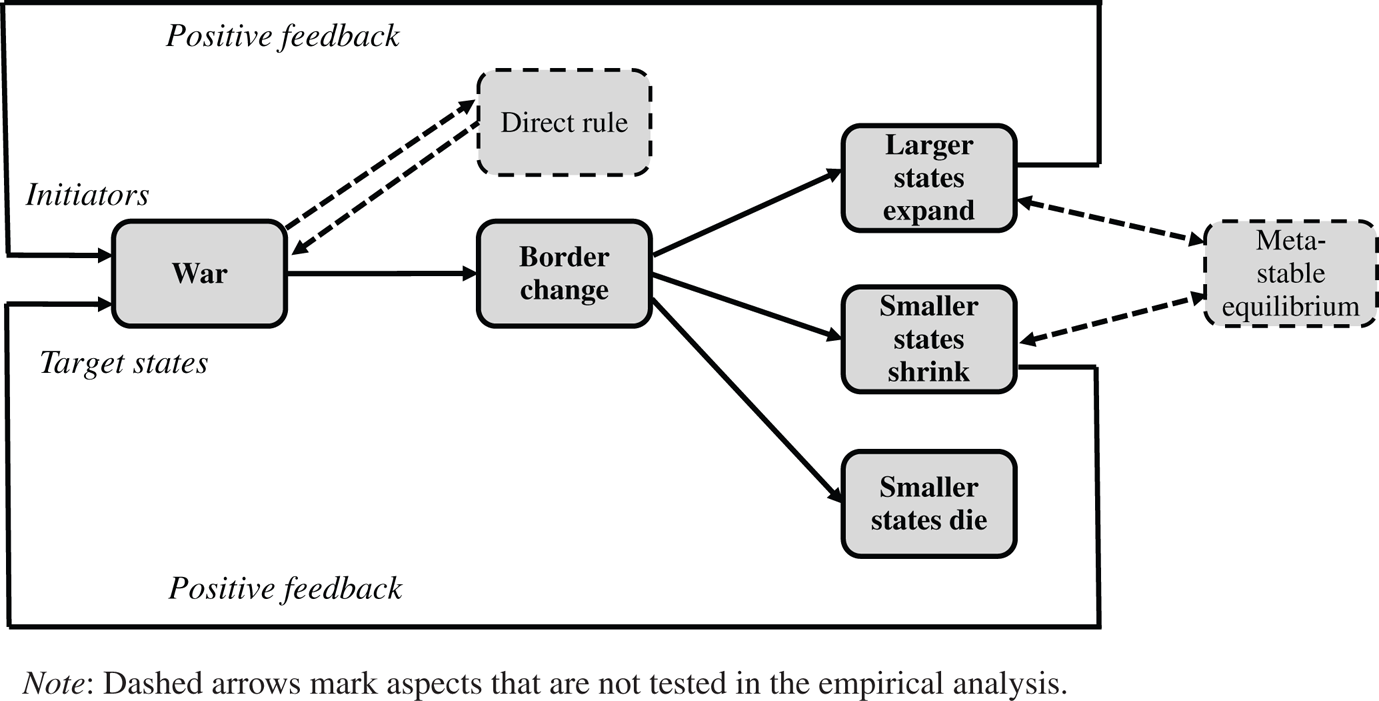
Figure 1. The bellicist model of war and border change
Yet the feedback loops do not run forever, or the entire state system would end up with a system-wide empire, which in fact the European system came close to under Napoleon and Hitler, and did happen in China.Footnote 35 While they are not always well articulated in bellicist accounts, especially not in Darwinian simplifications of the theory, there is an implicit set of countervailing factors that dampen the expansionist loop and the state-contracting cycle.
Instead of following an ever more divergent trajectory in size and power, the states in the European state system frequently reached an equilibrium thanks to various balance-of-power mechanisms. These are precisely the mechanisms mentioned by Spruyt in his critique of deterministic interpretations of Tilly's theory.Footnote 36 In a classic statement, Kenneth Waltz classifies these as “internal” and “external” balancing.Footnote 37 The former concept pertains to states’ attempts to increase their military capacity through armament, emulation, and innovation. Those states that were too weak to boost their capacity internally had to rely on external measures, such as defensive alliances, or seek protection through terrain features that slow down the positive feedback of conquest.Footnote 38 Thanks to balance-of-power mechanisms of this type, metastable equilibria emerged. While often quite stable for a long time, these equilibria were vulnerable to changes in weapons technology and geopolitical constellations.Footnote 39 It should be noted, however, that our empirical models only partially test the conditions leading to these equilibria through selected control variables (dashed lines in the figure).
Finally, while our empirical focus in this study is on the external dimension, the diagram also includes the link between warfare and internal changes, to remind the reader that Tilly's theory prominently features this dynamic as well. According to the bellicist logic, the introduction of direct rule and other measures of centralization creates another positive feedback loop driving state expansion.Footnote 40
What are the observable implications of this dynamic model? To start with the first part of Tilly's famous dictum, we propose:
H1a The correlation between war and territorial expansion increases with pre-existing state size.
H1b The correlation between war and territorial shrinkage decreases with pre-existing state size.
The logic of these hypotheses hinges on whether large states tend to trigger war in the first place, while smaller ones are more likely to be the target of an attack. In case of war, the distribution of territory, if any, also makes a difference. Thanks to their vast territories, larger states have more resources to fight (and win) wars.Footnote 41 Hence, here the theory expects larger states to make the most important territorial gains. This in turn allows these growing states to extract even more resources. In addition, persistent warfare can be expected to improve fighting skills and military logistics in the long run.
Ultimately, the evolutionary nature of the theory and the reciprocal logic of its main argument have long-term, path-dependent consequences. Whereas some states will manage to absorb enough territory to increase the territorial concentration of the system, others will fall by the wayside. This dynamic is inherent in Tilly's coercive logic: “Coercive means, like capital, can both accumulate and concentrate.”Footnote 42 There are at least three partly overlapping mechanisms that contribute to a snowball effect of conquest.
First, aggressors can draw on cumulative resources gained from conquered provinces. For example, during the Thirty Years’ War, Sweden engaged in such successful resource extraction from conquered territories in Germany that it hardly needed to increase taxation at home.Footnote 43 Subsequently, Prussia emulated this strategy in its own territorial expansion, which most prominently included resource-rich Silesia.Footnote 44 In contrast, peaceful gains acquired through dynastic marriages have tended to be smaller and arguably less related to a strategic logic. The marriage pools available to monarchs, and thus the territories they could gain peacefully, were limited by distance and, after the Reformation, confession.Footnote 45 Furthermore, territories gained through peaceful treaties of union usually involved provisions of autonomy, narrowing the resources to be gained from these provinces.Footnote 46
Second, rather than reflecting a long-term plan, military experiences during persistent warfare forced tactical innovation and organizational reforms that made the army even more fit for further expansion.Footnote 47 For example, Russia's Peter the Great's confrontations with the Swedes in the 1700s led him to westernize his army, which facilitated later conquests of Livonia and Eastern Finland.Footnote 48 Pacific expansion yielded no such direct benefits.
Third, while enlarged territory brought with it prestige in general, past military success served as a propagandistic tool that legitimized the state as a whole. Downing describes this logic in the case of Prussia: “Military victory became the basic edifice of legitimacy for the state.”Footnote 49 The confidence gained from previous conquests also motivated further expansionist claims, as in the case of France's pretensions in the Italian Peninsula during the early sixteenth century.Footnote 50
This reasoning does not imply that pacific processes were unable to accelerate state expansion. A shift from fragmented and unstable polities caused by partible inheritance to one based on primogeniture created ever larger dynastic unions.Footnote 51 In this process of “dynastic consolidation,” it was a change in Medieval inheritance practices rather than war-related developments that allowed European states to grow. Whether this dynamic was characterized by positive feedback is less obvious, but prestige and wealth accumulation may be plausibly postulated to have this effect. Indeed, Gorski and Sharma report that the number of dynasties declined from twelve to five from 1300 through 1610,Footnote 52 but this could be an indirect outcome of conquest and warfare. It should also be noted that the bellicist logic is compatible with threats of war rather than warfare itself. For this reason, our robustness analysis includes tests of the link between state size and further expansion irrespective of actual war fighting.
The mechanisms also operate in the other direction. A loss of provinces, a lack of military experience, and the demoralizing impact of past defeats can be expected to accelerate a state's decline.Footnote 53 These processes prompt the following hypotheses regarding the positive feedback of war-related territorial gains/losses:
H2a Territorial gains from warfare increase with previous war-related gains.
H2b Territorial losses from warfare increase with previous war-related losses.
By implication, the bellicist paradigm expects the corresponding peaceful processes to have weaker effects on state size. It should be noted that these hypotheses compress war initiation and territorial redistribution into one step. Thus, states with a successful record of war-driven expansion will be more prone to start wars than states with a more modest record. Conversely, the vicious cycle of territorial decline (H2b) implies that previous war losses will make such states likely targets of attacks. Moreover, the cumulative logic should also affect the outcome of wars, such that the most successful war fighters will be the ones that gain the most, and vice versa (for details, see the online supplement).
Following Tilly, this means that we need to study the European state formation process from the early sixteenth century, when the military revolution gained speed.Footnote 54 More specifically, Tilly points to the year of 1490,Footnote 55 which marked a new phase in the coercive expansion of European states. Given the fragmentation of political authority and the absence of clear borders in medieval Europe, it becomes much more problematic to measure, let alone conceptualize, the “shape” or “size” of the system's main units the further back one goes. Indeed, the idea of well-defined territories applied only partially to the European continent, and even well into the modern age there were many units that lacked clearly demarcated borders.Footnote 56
Although our empirical focus will be on the period until 1790, it is instructive to go beyond the French Revolution, which also marks the endpoint of Abramson's data set. While this epochal event constituted a major upheaval in the state formation process, a complete test of the bellicist paradigm requires analysis of the period afterward as well. We return to this issue at the end of the paper.
While the historical nature of the bellicist paradigm precludes straightforward causal identification, our empirical strategy relies on descriptive statistics and regression modeling applied to several levels of analysis to test the link between warfare and territorial expansion. Still, the macrohistorical focus of bellicist theorizing means that systemic analysis is a natural starting point. After that, we disentangle the belligerent and pacific components of states’ territorial gains and losses. Finally, we go beyond existing work by providing a dyadic analysis of armed disputes and border change featuring all state pairs in early modern Europe.
Data Description
To test our hypotheses, we match geocoded data on state borders with data on warfare, focusing on the period from 1490 to 1790. For measures of historic borders, we primarily rely on Abramson's spatial data on early modern European states.Footnote 57 Abramson's data set provides data for every five-year period, based on the Centennia Historical Atlas,Footnote 58 Euratlas,Footnote 59 and other sources. States are defined as territorial units that are not occupied by a foreign power, have the capacity to tax, and enjoy a common executive.Footnote 60 Furthermore, Abramson often considers units seemingly under outside control, such as those constituting the Holy Roman Empire or preceding the United Kingdom, as states in their own right as long as they acted “as if” they were independent (see the online supplement for details).
For robustness checks, we also rely on the Centennia Historical Atlas,Footnote 61 which covers European history until 2003 and defines states based on “de facto” control. Again, we restrict the sample to the period starting in 1490, but only go as far as 1915, since we anticipate that beyond that point the logic of state formation became increasingly transformed by nationalism, especially through the creation of new states and the disintegration of multiethnic empires.
As mentioned, we also directly link border change to conflict data. We establish this link by matching state units recorded by Abramson and Centennia with data gathered by Brecke that record all violent conflicts since 1400 AD in which at least thirty-two persons died.Footnote 62 Our conflict list identifies the actors that fought on either side of each war, along with its start and end dates. Following Tilly, we consider interstate wars only, excluding internal conflicts. In total, our data set records 346 interstate wars (for details, see the online supplement).
Systemic Analysis
What are the observable implications of Tilly's theory at the systemic level? One key implication is that warfare increased the territorial concentration of the European state system.Footnote 63 Through conquest and related types of territorial expansion, some persistently belligerent states became larger, while peaceful ones remained small or were possibly absorbed by more powerful polities.
There are many possible ways of measuring territorial concentration. The simplest would be to count the units, and indeed, the number of states decreased from 263 in 1490 to 215 in 1790 in Abramson's data set.Footnote 64 However, this raw count ignores state sizes, which means that a very large number of tiny states would make the system seem much more fragmented than it really was.Footnote 65 Alternatively, one could attempt to capture concentration through the size of a “typical state” in a fitted log-normal distribution of state sizes.Footnote 66 But this approach, too, may give too much weight to tiny statelets and downplay the role of great powers.Footnote 67
For a theoretically more meaningful indicator of territorial concentration we propose a measure that reflects to what extent state borders compartmentalize the system's total territory. We define territorial concentration using the Herfindahl index, that is,
where s i ∈ (0, 1] is the size of state i's territory as a portion of the system's total area. Rather than merely counting states, this is a truly spatial measure that tells us what the probability is that two randomly chosen locations in the system belong to the same state. If Europe were dominated by a single empire, this number would be 1. Conversely, if each location were governed by its own state, the system's concentration would be close to 0.Footnote 68
The territorial concentration of Europe was extremely low at the end of the Middle Ages, but then more than doubled, from 0.09 in 1490 to 0.23 in 1790 (Figure 2). The increase was quite steep in the early sixteenth century, but remained steady until 1790, although there were a few short-term fluctuations along the way. Moreover, as we show, territorial concentration continued to rise until the early twentieth century.
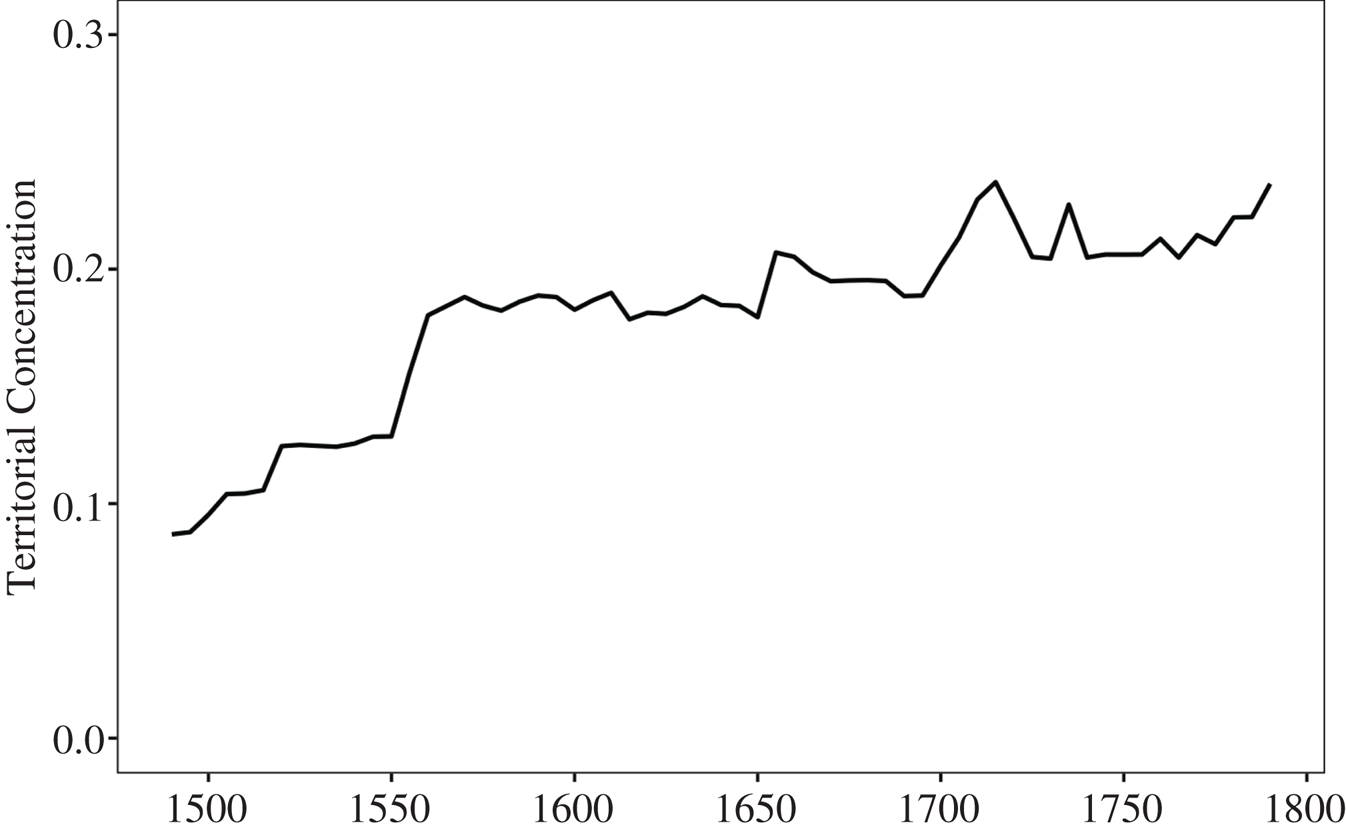
Figure 2. Territorial concentration in Europe, 1490–1790 (data from Abramson Reference Abramson2017)
Yet this summary statistic offers merely circumstantial evidence, since it entirely ignores warfare. To take a first step toward considering conflict behavior, we study territorial state sizes depending on whether the states in question experienced plenty of warfare. As outlined earlier, the belligerent states should become larger than those with a more peaceful record. Offering such a comparison, the ridge plot in Figure 3 divides European states in 1590, 1690, and 1790 into belligerent and pacific categories, depending on how much warfare they had been involved in since 1490. Specifically, belligerent states are defined as those that spent at least a quarter of the time since 1490 at war. In agreement with the bellicist paradigm, the diagram shows that the warring states are much larger than the peaceful ones, and the two distributions diverge gradually. While the former category shifts toward larger sizes, especially by losing its smallest states, the latter one loses some of its largest members.Footnote 69
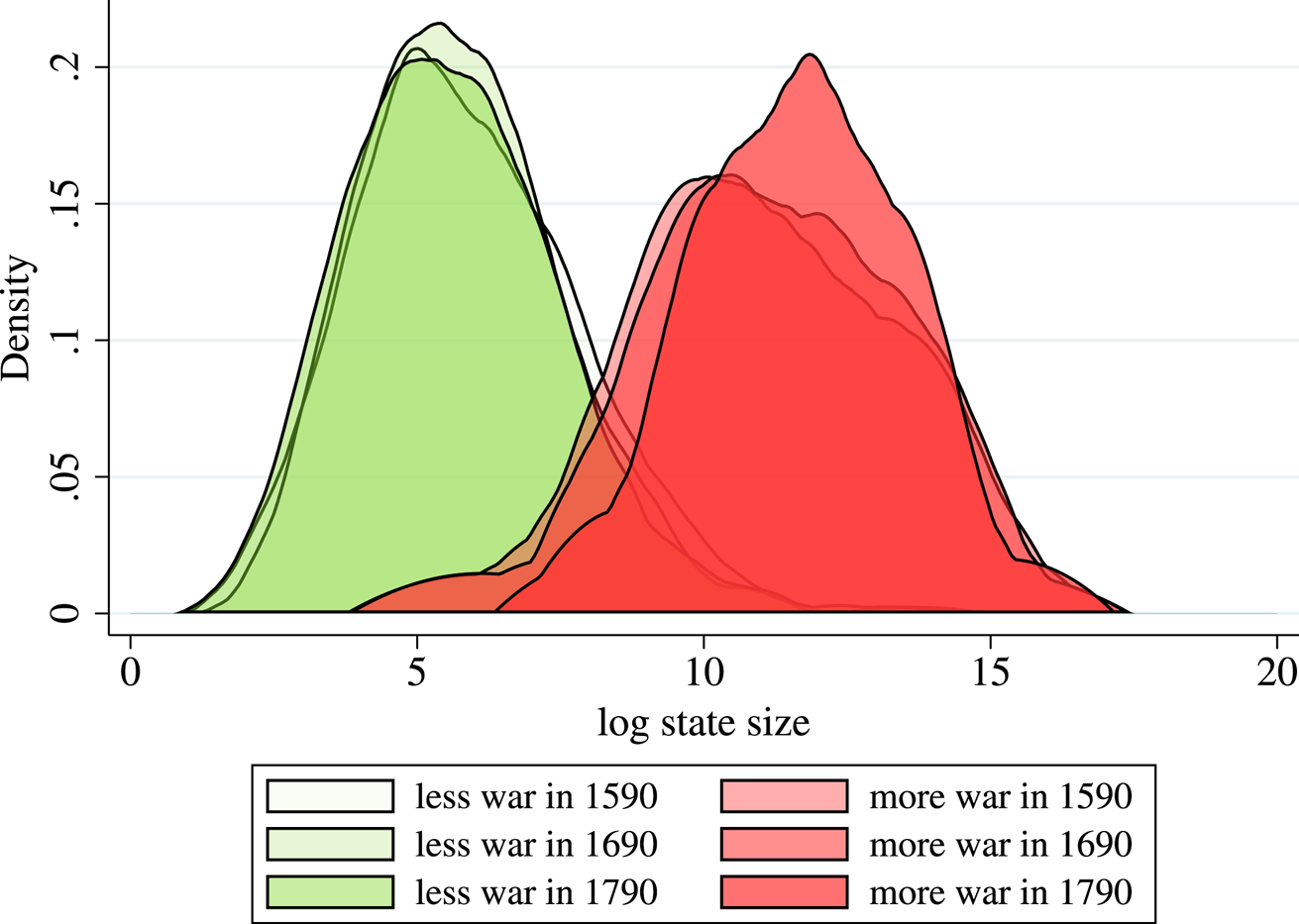
Figure 3. Comparing the territorial size of warring and peaceful states (data from Abramson Reference Abramson2017)
Our systemic analysis gives us some suggestive indications about the link between warfare and territorial expansion, but the connections remain entirely descriptive. The main problem is that our findings derive from comparisons of highly aggregated data. To get a firmer grip on the nexus between state formation and warfare, we need to disaggregate our analysis, starting with the state level in the next section, and moving to the dyadic level in the subsequent section.
State-Level Analysis
Going beyond system-level analysis, in this section we analyze the state-level dynamics of state expansion. We start by tracing the historical trajectories of four great powers to gauge whether their territorial growth can be attributed to violent or nonviolent processes. If Tilly's theory is correct, we should be able to detect a significant contribution of armed conflict to state expansion.
Before discussing great-power trajectories, we illustrate how to distinguish war-related territorial gains from peaceful ones. To this end, we combine dyadic data on warfare with spatial data on territorial transfers. By overlaying country polygons at time t with polygons from t − 1, we can record territorial gains and losses between each state pair in Abramson's data set. Since European history is replete with great powers that fought noncontiguous states, as illustrated by Spain's conquest of the Netherlands, we will consider both contiguous and noncontiguous dyads. For each case of state A's territorial gain against state B, our procedure sorts the gains into three categories. War-related gains are recorded if the expansion occurred during or immediately after a war in Brecke's list that involved states A and B on opposite sides. This relational correspondence guarantees a relatively close connection of the two categories of events.Footnote 70 Peaceful gains comprise all territorial expansions by state A at the expense of state B where the two states did not participate in a conflict on opposite sides. Lastly, territorial expansion may concern politically unclaimed areas, which we refer to as terra nullius.
Figure 4 illustrates this procedure in a hypothetical example, in which states A, B, C, and D exchange territory under violent and peaceful conditions. Clearly, this dyadic linking of war to territorial gains constitutes a conservative measurement in coding gains as war-related only if there is an explicit match between Brecke's warring parties and Abramson's political units. Thus we are likely to underestimate the link between warfare and territorial change, since our coding excludes conquests resulting from threats of violence or minor skirmishes that do not pass the threshold of war (see the online supplement for details).
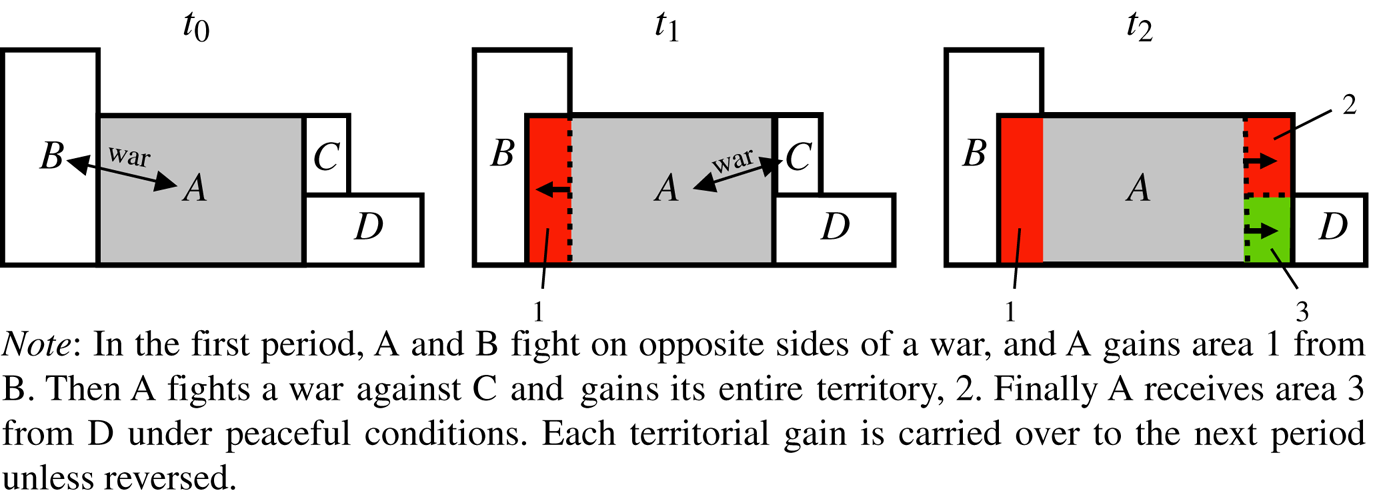
Figure 4. Computing the cumulative territorial gains of state A from its neighboring states B, C, and D
We rely on extensive spatial computations to trace each state's trajectory over time, keeping track of all territorial gains beyond its core territory as of 1490. Stacking these areas on top of each other, Figures 5a–8a depict the trajectories of Prussia, France, the Habsburg Empire, and Russia, respectively. The corresponding maps (Figures 5b–8b) display the situation in 1790. Following Tilly's approach to state formation, the computation starts in 1490. In this year, we identify the “core” as the territory of the state, here colored beige, and study territorial expansion beyond this area. Any territorial expansion beyond the core is sorted into three main categories, “war,” “peace,” and “terra nullius,” based on the aforementioned dyadic classification. All gains associated with violent conflict between the state in question and the losing state are added to the “war gains.” Any other expansion at the expense of other states is “peace gains.” Finally, expansion into unclaimed terrain is summed up as “terra nullius gains.”
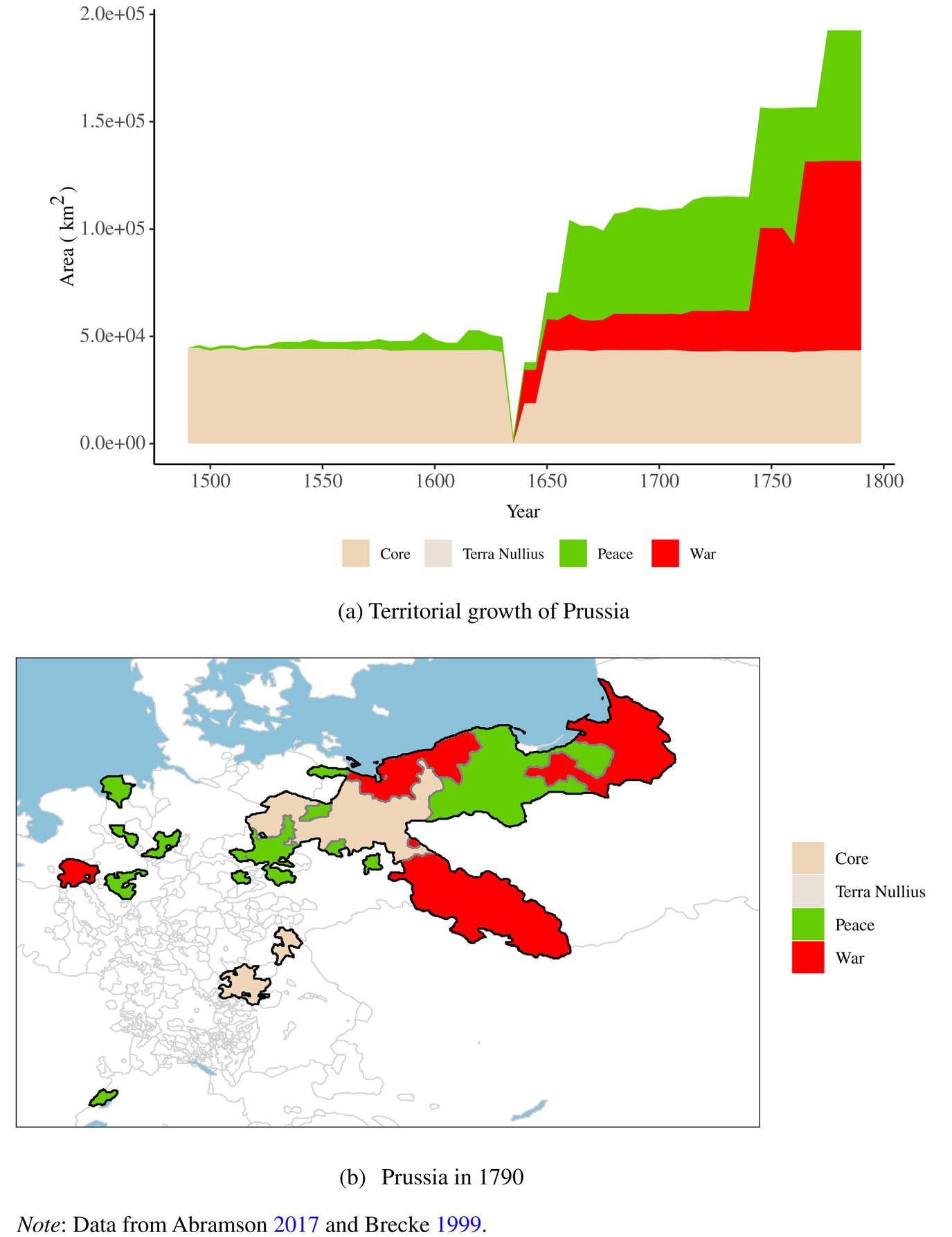
Figure 5. War-related and peaceful territorial growth of Prussia, 1490–1790
The Case of Prussia
Categorized by Tilly as following a “coercion-intensive” trajectory,Footnote 71 the history of Prussia serves as a clear example of a bellicist state formation process before the French Revolution. Figure 5a reveals a striking growth trajectory that was primarily driven by war, as illustrated by the area from the mid-seventeenth century on. Before this process, the Hohenzollern added a few holdings to their territory through marriage.Footnote 72 During a Swedish occupation in the Thirty Years’ War, they briefly lost control over their core.
In the aftermath of the Thirty Years’ War, Prussia conquered parts of Pomerania (territory in the north), and a decade later, conquest during the Great Northern War allowed Prussia to wrest East Prussia away from Poland (territory in the east). Still feeling threatened on various fronts around the core and in need of resources, Frederick I and his successor, Frederick the Great, embarked on further expansionist campaigns.Footnote 73 To widen the resource base, the Prussian monarchs set out to conquer new territories, which aggravated existing rivalries and led to further wars and conquests.Footnote 74 This self-reinforcing process included the Silesian War with the Habsburgs, which allowed Prussia to gain the rich province of Silesia (area in the south), and the Seven Years’ War. The latter led to a temporary occupation of Saxony and forced Prussia to expel its rivals from East Prussia and the former Julich-Cleves-Berg Province (areas in the east and west, respectively). Overall, war transformed Prussia from a loose set of territories in 1490 to a much larger and more cohesive unit, a development that would continue in the following century, culminating with the unification of Germany.
The Case of France
If Prussia represents an ideal-typical case of coercion-intensive growth, France experienced a more balanced development featuring “capitalized coercion.”Footnote 75 The overall territorial growth of France was modest, especially compared to its territorial core in 1490 (Figure 6a). From this point until the French Revolution, France gained somewhat more new territory peacefully than it did through war.Footnote 76
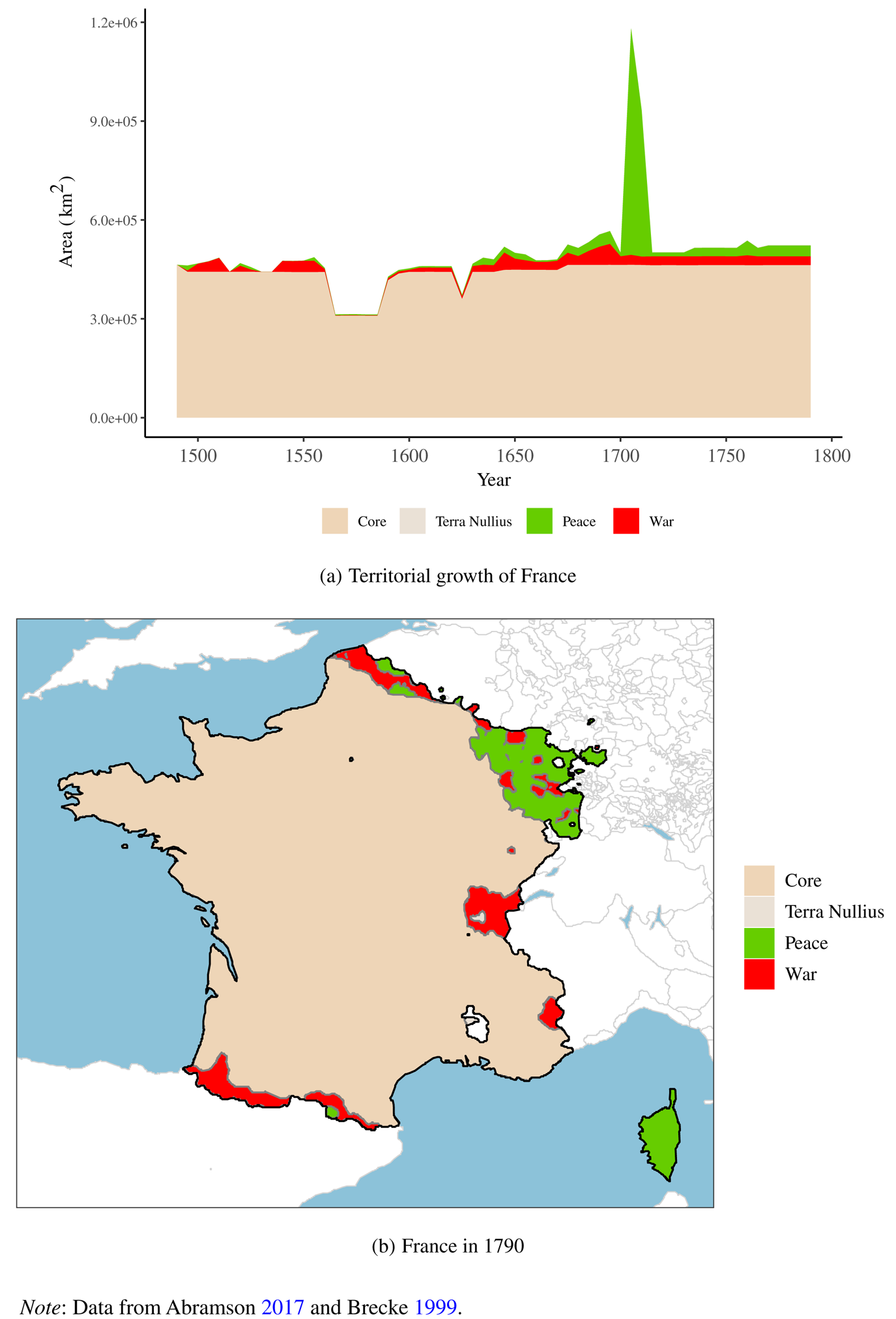
Figure 6. War-related and peaceful territorial growth of France, 1490–1790
In the sixteenth century, the French shifted their attention beyond the Alps, where they confronted the Spanish in the Italian Wars, and toward the Rhine, where they faced the Habsburgs. These wars led to permanent gains including the imperial territories of Metz, Verdun, and Toul. After the loss of parts of the core territory during the French wars of religion,Footnote 77 fifty years of warfare in the seventeenth century secured a series of territorial gains. France sought to conquer territories proximate to the Alps, the Pyrenees, and the Rhine—and succeeded, to a certain extent. The Thirty Years’ War let it wrest areas close to the Pyrenees and the Rhine from Spain, while Franche-Comté and Transalpine Savoy were gained in the Franco-Savoyard War and the War of the Spanish Succession.
While France's peaceful gains are noticeable in Figure 6b,Footnote 78 it is also striking that a lot of what we know as France's contemporary shape was gained through warfare and conquest in this period. The idea of “natural frontiers” legitimized state expansion, as these borders were seen as important for defensive purposes. Even after having reached these frontiers, Napoleon continued to employ this discourse to justify further expansion.Footnote 79 Thus, both before and after the French Revolution, the bellicist interpretation holds up quite well, although the expansion was more modest than in the Prussian case.
The Case of the Habsburg Empire
While France made relatively moderate gains from the sixteenth century, the Habsburg and Russian empires achieved the greatest territorial expansion until the French Revolution. Despite their relative backwardness and delay in implementing direct rule, their outward expansion largely matches the bellicist account.
Conventional accounts of Habsburg geopolitics normally focus on the famous dictum “Bella gerant alii, tu felix Austria nube” (Let others wage war, but thou, happy Austria, marry). According to this popular interpretation, Austrian expansion happened primarily thanks to strategic dynastic marriages. Of course, there is no denying that these dynamics account for much of the early growth of the empire; see the additions during this period in Figure 7a. Yet the figure also reveals that the pacific account obscures less peaceful aspects of Habsburg territorial expansion.Footnote 80
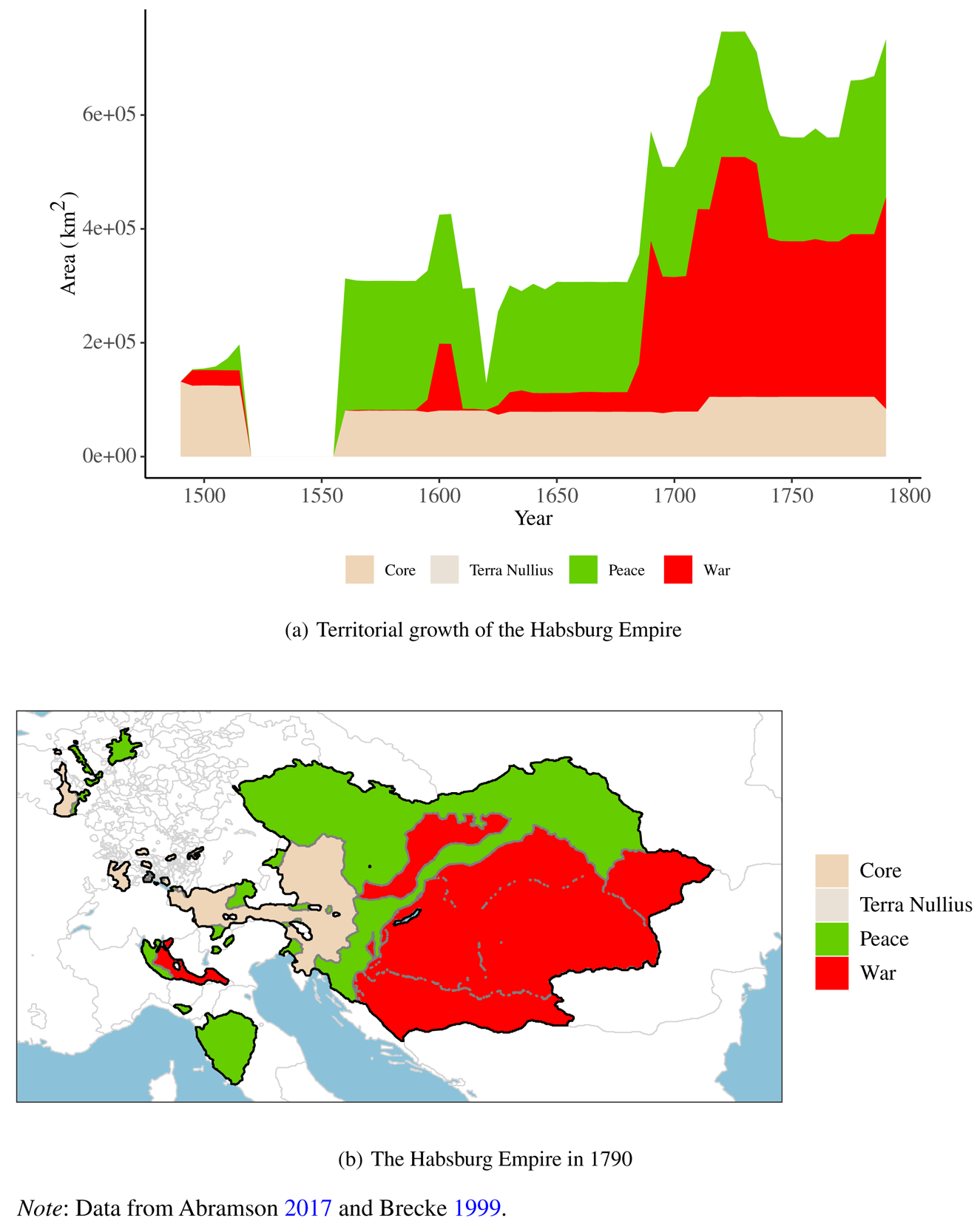
Figure 7. War-related and peaceful territorial growth of the Habsburg Empire, 1490–1790
As Wess Mitchell has shown,Footnote 81 the Habsburgs developed a sophisticated military strategy that allowed them to retain and defend their core territory, which comprised the Austrian Hereditary Lands, the Lands of the Bohemian Crown, and the Kingdom of Hungary, all of which were incorporated mostly through peaceful bargaining. In contrast, profiting from the weakness of the Ottoman Empire, the Austrians made huge, war-related gains on the southeastern front that shored up their overall resources and secured sufficient geopolitical depth. Without any intermarriage with the Ottoman dynasties, a series of conquests and reconquests led to a major expansion of the empire's territory (see the gains, especially from the late seventeenth century). Following the Turkish siege of Vienna in 1683, the Habsburgs pushed the Ottomans back in a series of successful campaigns that regained all of Hungary and added new territory in Transylvania and the Balkans, including Croatia, Banat, and most of Wallachia.Footnote 82 Furthermore, the Habsburgs were able to check Russian expansion in the east, while defending themselves against threats from the Prussians and the French in the west.Footnote 83 Although difficult geography and relative military inferiority forced the Austrians to adopt a mostly defensive grand strategy, they expanded opportunistically wherever the resistance was weak, as in the Ottoman case and in the case of Poland's partition, which led to major gains including Little Poland and Galicia.Footnote 84
Peaceful expansion in the north and parts of the Hungarian lands, and the otherwise primarily war-driven expansion in the southeast, resulted in a vast empire that included scattered holdings in what is today Italy, Southern Germany, and the Netherlands (Figure 7b). Remarkably, the Habsburg Empire managed to survive the turmoil following the French Revolution and the Napoleonic wars for more than a century, until its ultimate demise at the end of World War I.
The Case of the Russian Empire
In contrast to the Habsburgs, the Russian Empire has been characterized by most historians as a belligerent and expansionist state. War accounts for most of its territorial gains after the mid-sixteenth century (Figure 8a). Significant territorial gains (blue “terra nullius” in Figures 8a and 8b) also resulted from Russia's conflicts in the east, involving Manchus and Chinese forces (outside the map), and confrontations with various nomadic groups in both the east and the south.Footnote 85 It should be noted that our data set's coverage of Russia is limited to its European part, so we cannot fully account for Russia's eastward expansion.
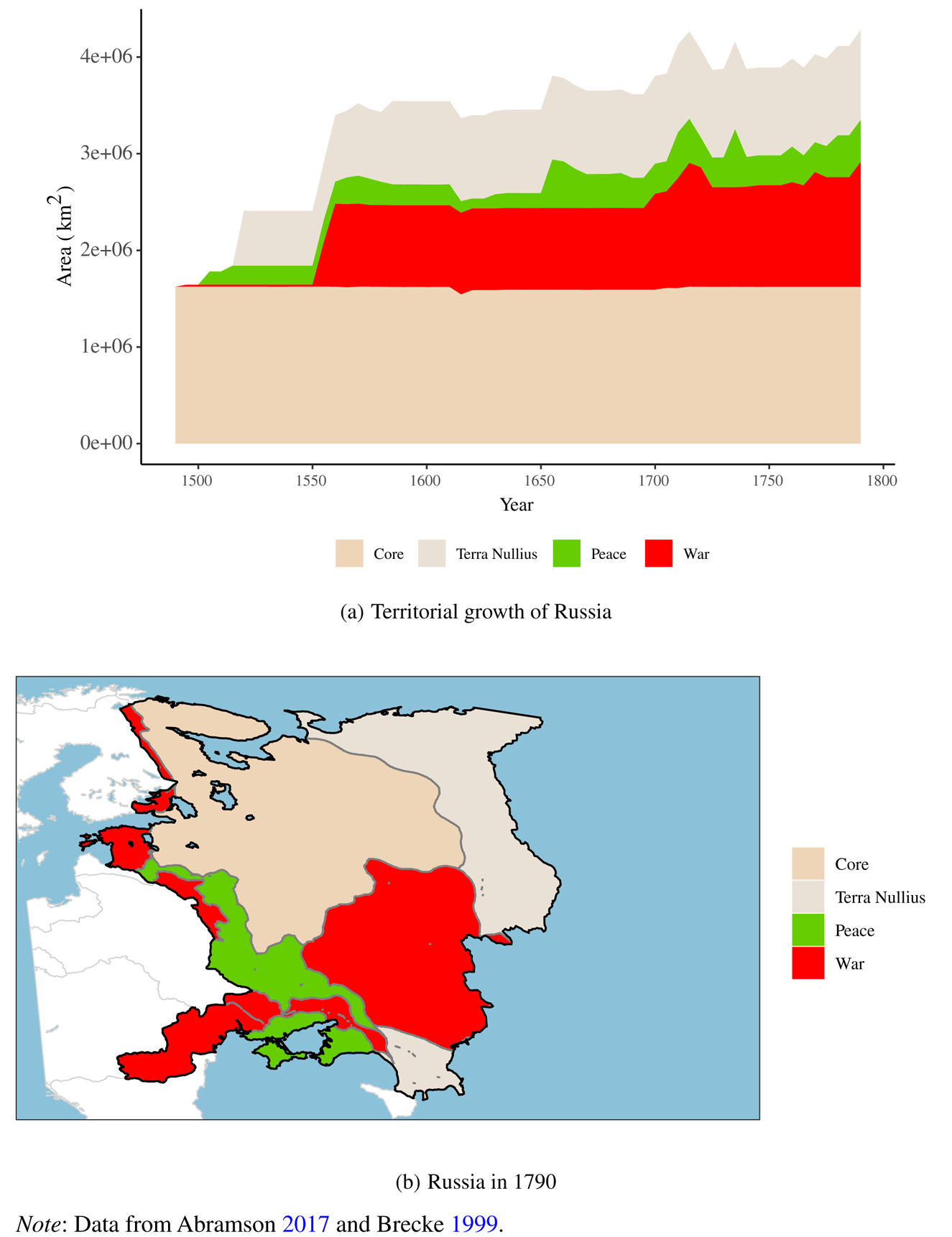
Figure 8. War-related and peaceful territorial growth of Russia, 1490–1790
The first waves of conquests from the mid-sixteenth century on involved the annexation of the Kazan and Astrakhan khanates (areas south of the core in Figure 8b), which were remnants of the Mongol Empire.Footnote 86 Determined to establish hegemony in both the west and the south, the Muscovite dynasty spent several centuries in perpetual warfare.Footnote 87 In the west, Russia was confronted with both Sweden and Poland-Lithuania. The Great Northern War, the Northern War, and the Russo–Swedish Wars yielded major gains from the Swedes around the Gulf of Finland, as well as the former territory of the Teutonic Order from Poland-Lithuania, and further gains through the partition of Poland in 1772.Footnote 88 In the south, the Russian tsars successfully fought the Ottoman Empire and its client state, the Crimean Khanate, over control of the Black Sea's basin.Footnote 89 In sum, persistent warfare and conquest allowed Russia to make significant territorial gains in the northern, southern, and eastern theaters. In this sense, Russian history until 1790 (and beyond) fits Tilly's coercion-intensive trajectory.Footnote 90
Large-N Analysis of Gains and Losses
The four great-power trajectories we have just considered offer suggestive evidence that positive feedback was operating in specific cases, but they do not provide systematic support for any of our main hypotheses. Furthermore, the descriptive analysis only highlights what happens to successful polities. To counteract bias resulting from an exclusive focus on states that emerged as the “winners” from geopolitical competition, we now turn to formal statistical testing at the country level of both gains and losses. Here we rely on OLS estimation with year fixed effects to reduce the influence of geopolitical shocks. The two main dependent variables are each state's log-transformed territorial net gains and losses during each five-year period.
Table 1 presents six models, the first three accounting for territorial gains and the remaining three for losses. Crucially, all of the models feature a country-level war dummy variable, derived from the dyadic indicator, that is 1 if the country was involved in any dyadic war during each period and 0 otherwise. As a test of the dynamic aspect of bellicist theory, we also include cumulative variables that measure war-fueled and pacific growth from the first observation, as defined in the previous section on great-power trajectories. Furthermore, as a complement to these variables, the analysis introduces measures of cumulative losses, again using 1490 (or independence) as the reference point. In addition to the main independent variables, we include four geographic control variables: the log-transformed age of the state, whether it enjoys coastal access, its log-transformed number of contiguous neighbors, and the standard deviation of elevation (as a proxy for rough terrain). All models are estimated with standard errors clustered at the country level.
Table 1. Territorial change
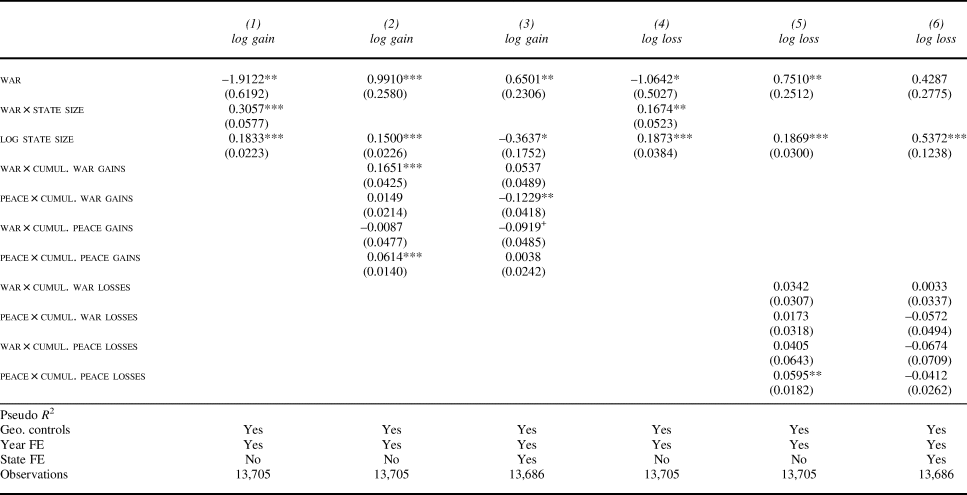
Notes: Standard errors clustered on states in parentheses. +p < .10; *p < .05; **p < .01; ***p < .001.
As a first tentative test of Hypothesis 1a, we interact the war dummy with (log) territory size. In general, as expected, larger states expand more than smaller states, but this growth becomes much steeper during wartime already for moderately sized states (Figure 9a). To evaluate the dynamic version of this association (Hypothesis 2a), model 2 interacts the war dummy with the cumulative-war-gains variable. For ease of interpretation, the table includes two interaction terms, one with war and the other one with peace (the complement of the war dummy).Footnote 91 In agreement with Hypothesis 2a, the coefficient associated with war-driven growth is large and highly significant (Figure 9c). Interestingly, peaceful growth is also linked to further expansion, but this effect is much smaller and limited to peacetime. To fully capture the internal growth logic of the bellicist model, model 3 adds country fixed effects to the same specification as in model 2. While the net effect points upward as expected, the estimate is now so small that it cannot be separated from 0.
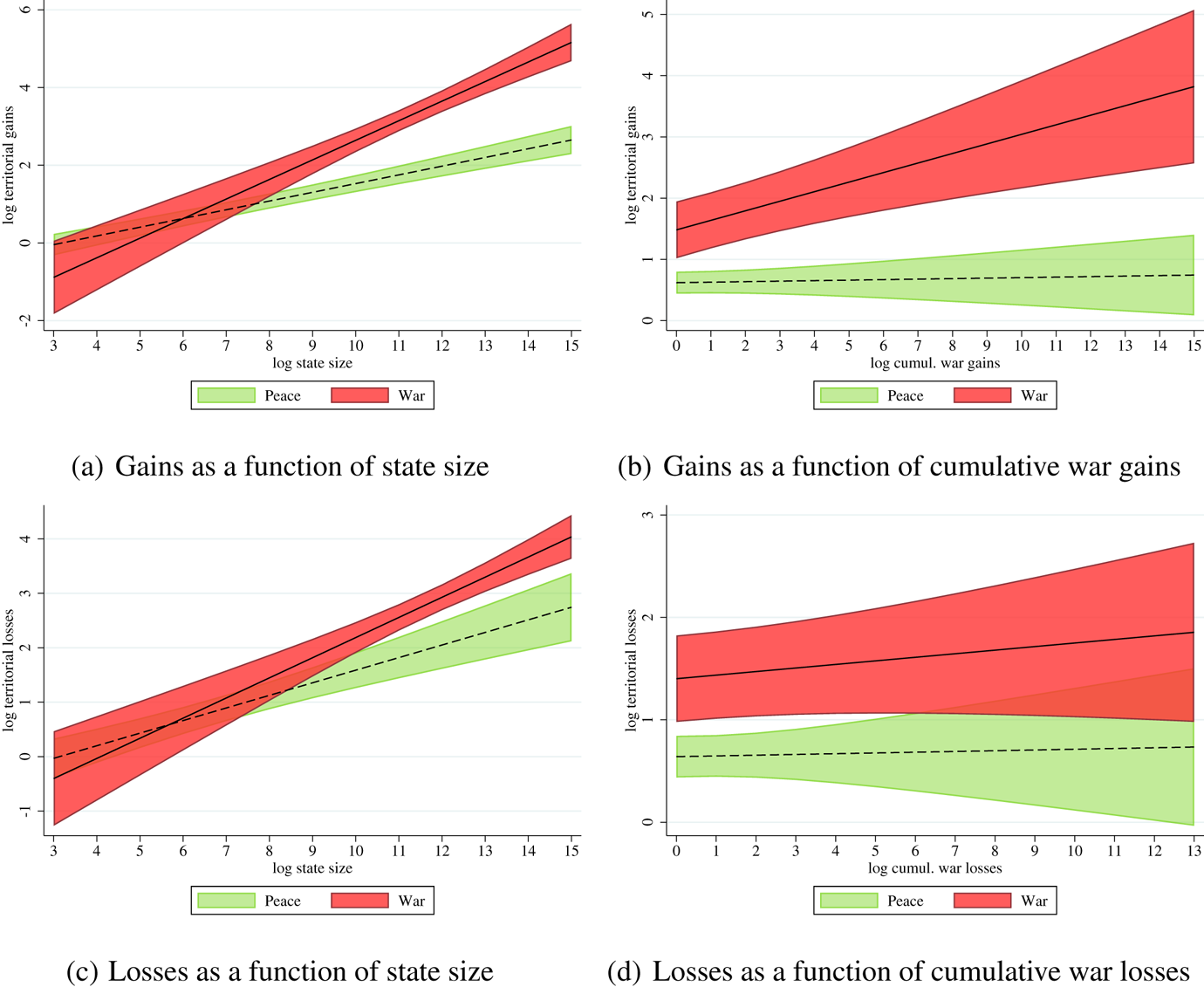
Figure 9. Territorial gains and losses at the country level, 1490–1790
Regarding territorial losses, support for the bellicist perspective is weaker. In model 4, war-driven shrinkage of smaller states cannot be confirmed since the net effect of state size on territorial losses slopes upward, albeit less steeply than in the case of gains (Figure 9b). Yet it should be kept in mind that the scope of the losses also hinges on the state's own territorial size because only large states can lose a lot of territory. Still, wartime losses are generally greater than those in peacetime, which offers some support for the theory. When we turn to the cumulative measures of past losses to assess Hypothesis 2b, model 5 displays the expected upward slope, but it is close to 0, with broad error bands (Figure 9d); and with fixed effects, this effect disappears entirely (model 6).
To gain more clarity, we complement the linear models of losses with state-level survival analysis that focuses on “state death” as the outcome of interest. We rely on the list of state units taken from Abramson, code a state's “death” if it ceases to exist in the subsequent five-year period, and estimate a series of Cox proportional hazard models. Standard errors are clustered on the country level.
The results are shown in Table 2. Model 1 tells us that while warfare in itself is only weakly associated with state death, state size exhibits a powerful positive association, in agreement with Abramson's findings.Footnote 92 This result contradicts “Darwinian” accounts of state formation. However, we also need to account for the interaction between war and state size because many states have ceased to exist for reasons unrelated to warfare, such as dynastic unions. Once we do this, the results are very much in line with the bellicist perspective. The coefficient for this interaction effect is negative and significant. To facilitate interpretation, Figure 10 visualizes these interactions. Again confirming the bellicist logic, and more specifically Hypothesis 1b, these results show that state deaths during wartime are far more common for small states than for larger ones, while the opposite holds in times of peace. As an additional test of the long-term dynamics of state mortality, model 3 introduces all four cumulative variables from the previous analysis. This addition is in line with an interpretation suggesting that states that experienced large territorial gains through war become “battle hardened” and are thus less likely to perish.Footnote 93
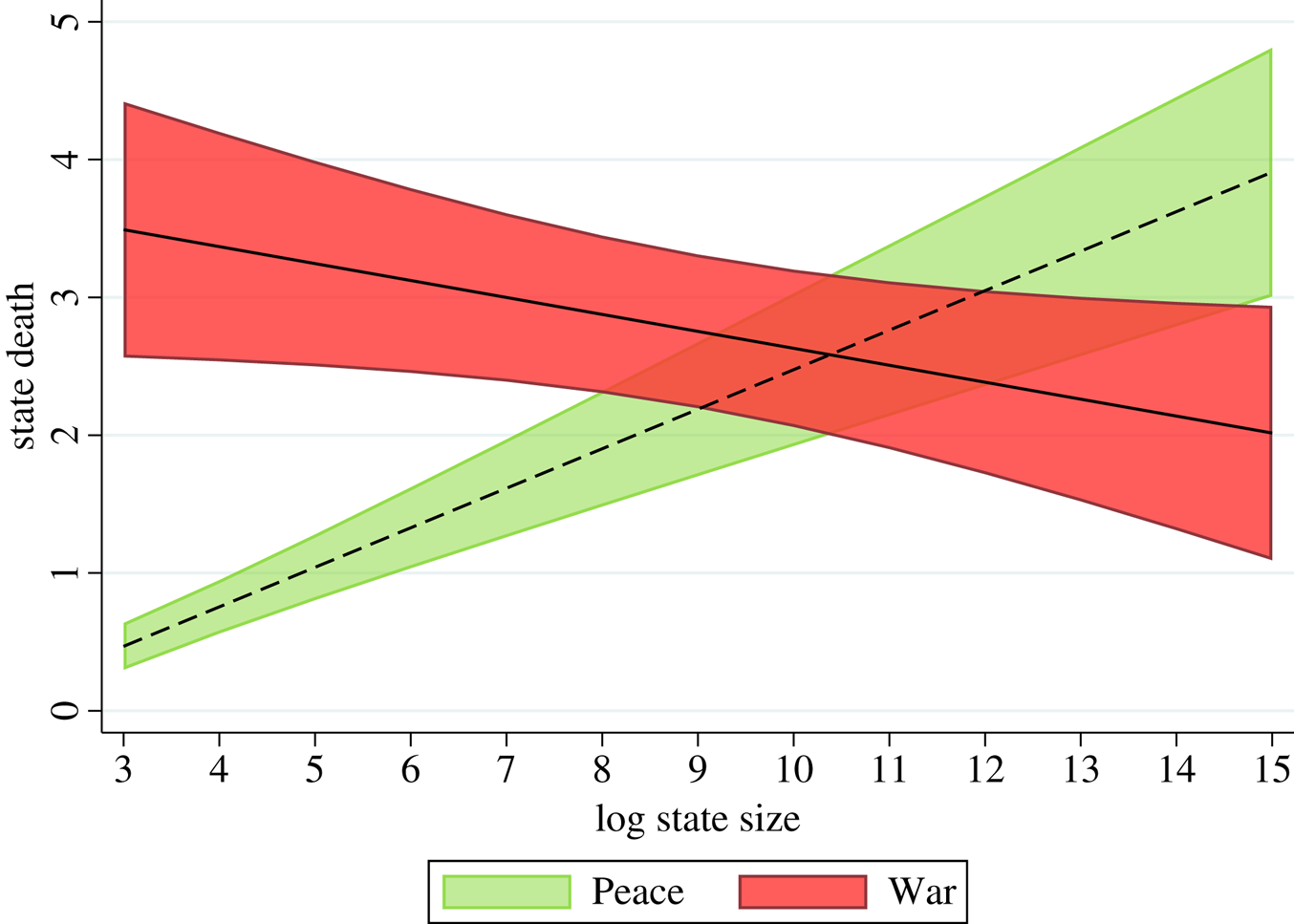
Figure 10. Effect of state size on state death during peace and war
Table 2. Cox proportional hazard models of state death
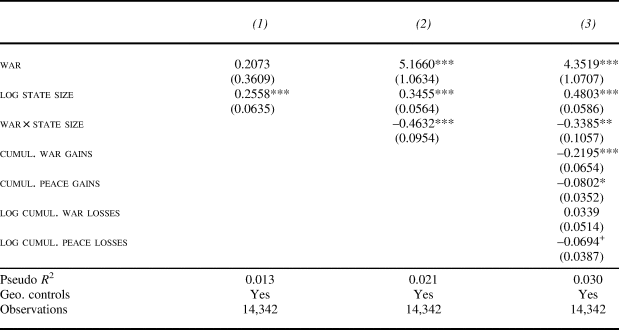
Notes: Standard errors clustered on states in parentheses.
+p < .10; *p < .05; **p < .01; ***p < .001.
To summarize, the results of our survival analyses align well with a world in which warfare was a key driver of interstate competition, state expansion, and, conversely, state death. Yet it is difficult to discern the effects relating to losses short of war at the country level. While the state-level analysis has narrowed the gap between conflict and territorial expansion compared to the systemic analysis, it is pitched at a relatively high level of aggregation. At the country level, the risk of ecological fallacies remains a concern, especially in the case of large countries with many neighbors, which may be involved in several simultaneous conflicts. For these reasons, we proceed by disaggregating our evaluation of bellicist theory to the dyadic level.
Dyadic Analysis
In this section, we base our investigation on directed dyads, each one composed of a state A and a state B. As in the previous analyses, we rely on state borders from Abramson's spatial data set.Footnote 94 For each time period with N states, there are N(N − 1) dyads. In a panel setup based on five-year periods, this configuration adds up to more than three million dyad-periods. It should be noted that this setup includes all dyads, even between noncontiguous states, since restricting the sample to neighboring countries would lose sight of many great-power interventions, for instance, by Spain on the Italian Peninsula and in the Netherlands.
Our dependent variable is the log-transformed territorial net gain of state A from the territory of state B, based on the same spatial computation used earlier. Since by definition both states cannot gain simultaneously, the corresponding dyad directed from B to A is dropped. Thus, by keeping all dyads in both directions except where state A gains territory from state B, each state has an opportunity to gain territory from any of the other states in the system. The factors driving losses can be studied through the variables associated with state B, which is by definition on the losing side.
The war variable is again taken from Brecke's data set and matched to the states in the Abramson data set, as described in the previous section. To reiterate, this variable equals 1 if states A and B fight on opposite sides in the same war, and 0 otherwise. Note that conflict incidence is now directly matched at the level of the dyad rather than at the country level. As in the country-level models, the dyadic analysis interacts warfare with the main size variables.
Rather than “raw” state sizes, the dyadic setup allows us to use the relative sizes of states A and B. Taking into account logistical constraints and decreasing returns to scale before the era of modern communication, we log-transform the sizes:
where S A and S B are the territorial sizes of states A and B. As an assessment of Hypotheses 1a and 1b, this comparison is more informative than absolute state size.Footnote 95
To test Hypotheses 2a and 2b, we introduce measures relating to war-related cumulative territories, either gained or lost. The cumulative-gains indicators are the same as those used in the country-level analysis. This implies that if one of the states has accumulated large war-related gains in the past, we would expect partial or full conquest to be more likely. In case of pacific gains, border change could also be facilitated, but the bellicist model expects expansion to be primarily fueled by warfare.Footnote 96 As a test of Hypothesis 2b, the variables holding cumulative losses are also used.
The models feature a series of control variables, including a dummy variable indicating whether the two states neighbor each other, and the log of the distance between them. We also control for the log-transformed area of state B, since gains are by definition made out of that territory.Footnote 97 Finally, the models include the geopolitical controls we relied on in the state-level analysis—coastal access, age, number of neighbors, and standard deviation of elevation. The indicators for distance and rough terrain allow us to partially test whether negative feedback operates along with positive feedback.
Table 3 summarizes our findings. Model 1 displays the results from a model featuring dyadic conflict as the main explanatory variable, along with the relative size of state A compared to state B. As expected, both variables come with strong positive and highly significant estimates. However, Hypotheses 1a and 1b expect that the effects of warfare and state size interact. Thus, model 2 introduces an interaction term between the war dummy and relative size. As postulated by Hypothesis 1a, the coefficient of the interaction term turns out to be quite large and significant, which is reflected in a steep slope (Figure 11). While larger states grow in peacetime as well, the rate is very slow compared to their wartime expansion. Conversely, if B is smaller than A, losses are more likely, as anticipated by Hypothesis 1b. To illustrate the interaction, Figure 11 shows how A's territorial gains (and thus B's losses) vary with its relative size. In agreement with bellicist theory (Hypotheses 1a and 1b), territorial expansion is strongly dependent on size.
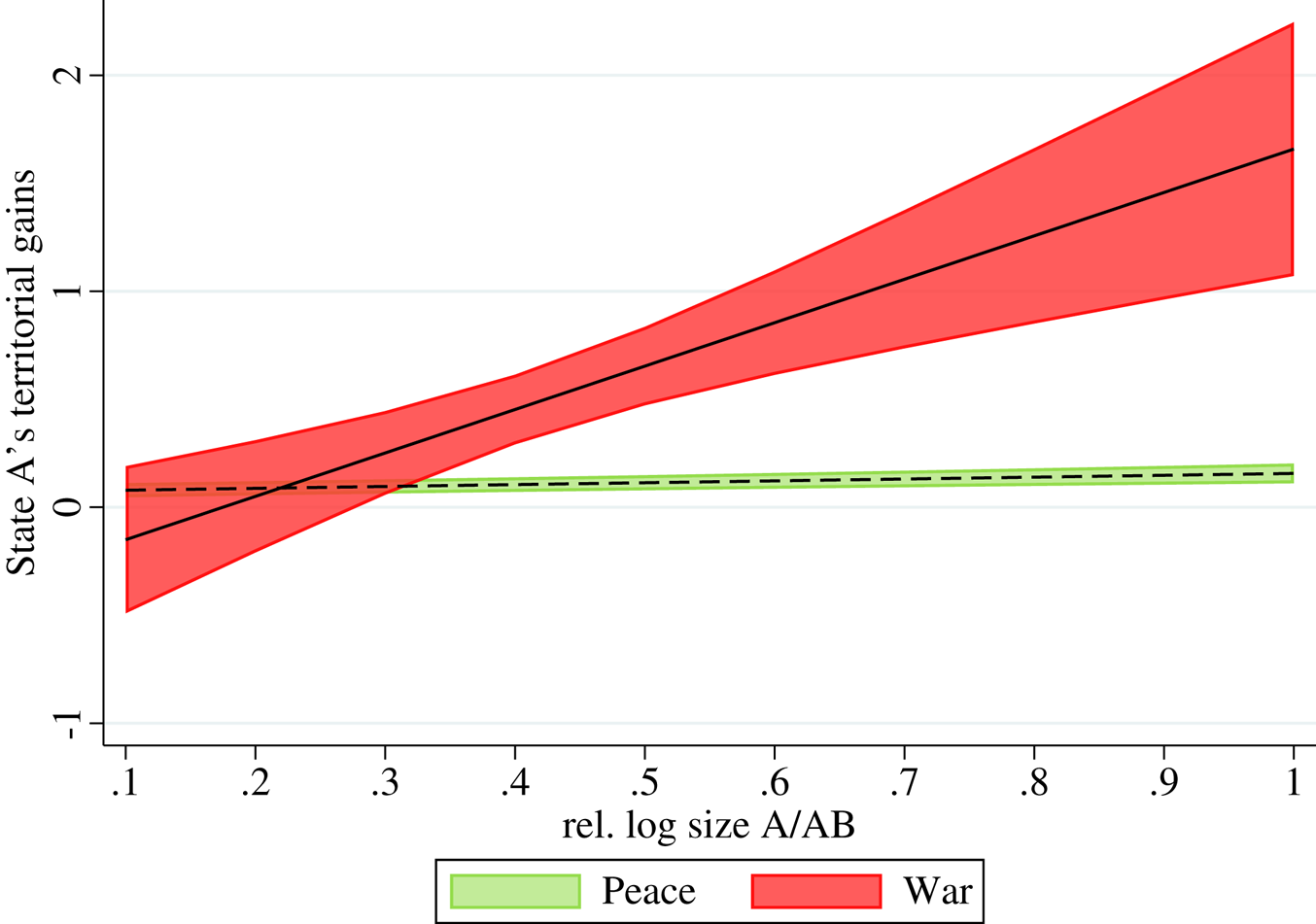
Figure 11. States A's dyadic gains as a function of its relative size
Table 3. Dyadic analysis of gains of State A and losses of State B
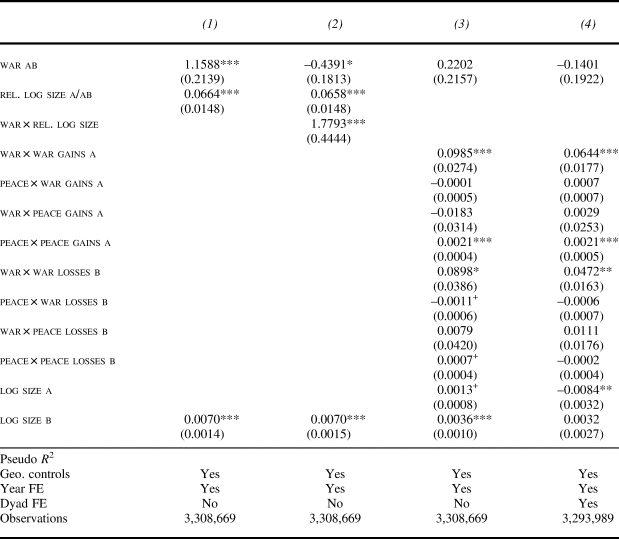
Notes: Standard errors clustered on states in parentheses.
+p < .10; *p < .05; **p < .01; ***p < .001.
In this and the remaining models, the confounders also behave as expected: neighbors and proximate states are much more likely to exchange territory. State A's gains and state B's losses increase with state age on both sides and with coastal access of state A (but not of state B) and, as expected, decrease with rough terrain, especially in state B. Again, this confirms that the positive-feedback mechanism in Hypothesis H2a is constrained by countervailing forces.
Model 3 gives us an opportunity to evaluate Hypotheses 2a and 2b directly. Here we interact the war dummy with the cumulative-growth variables while showing the resulting wartime and peacetime effects in the same manner as was done in the state-level analysis (Table 1). Generally, territorial changes are much more modest in peacetime. In support of Hypothesis H2a, the war-driven expansion trajectories appear to be strongly self-reinforcing. Likewise, there is a positive-feedback dynamic affecting states’ wartime losses after having experienced large cumulative war-related losses in the past, corroborating Hypothesis H2b. This finding answers the question posed by the weak country-level losses in models 5 and 6 of Table 1.
To facilitate evaluation of the interaction with war, Figure 12a provides a graphical illustration of the relationship. The coefficient for past peaceful gains, however, remains much smaller, although it is also highly significant. As a further piece of evidence in favor of the overall theory, the findings confirm Hypothesis 2b: past war-related losses put downward pressure on state B's territory, which is robust evidence in favor of the lower feedback loop in Figure 1. While the size of the coefficient is cut in half compared to model 3, the association is now more precisely estimated. Figure 12b provides a visual illustration of this finding.
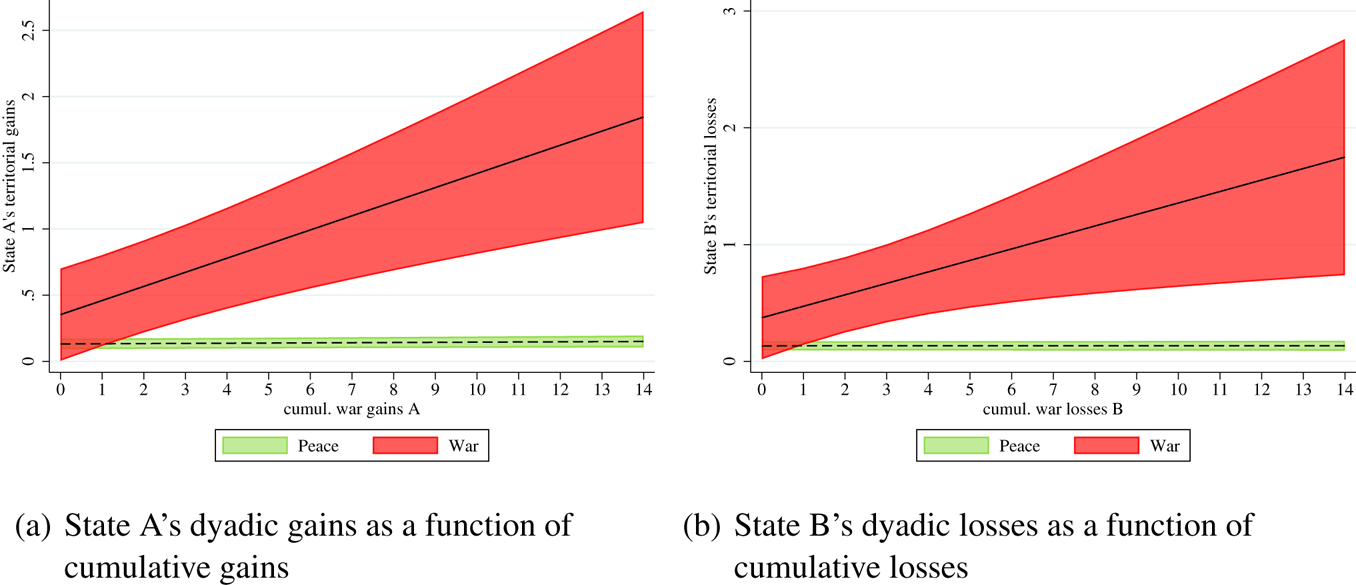
Figure 12. Territorial gains and losses at the dyadic level, 1490–1790
Taking one further step toward assessing the double positive-feedback dynamic in the bellicist model, model 4 introduces dyad fixed effects in addition to the year fixed effect of the previous models. This tougher test allows us to compare conflict periods to peaceful ones while disregarding cross-state/dyad heterogeneity. Lending strong support to Hypothesis 2a, the war-driven cumulative-gains variable retains most of its effect, with high precision in the estimate. While not shown in the table, negative and significant coefficients for distance and rough terrain confirm that there are negative-feedback effects that counterbalance the snowballing logic of Hypothesis 2a.
As another important step toward validating the underlying mechanisms, the online supplement (section B) features a supplementary analysis of the link between war and border change in the context of peace agreements. Most wars in early modern Europe ended with a formal peace treaty,Footnote 98 and we can use this fact to close the analytical gap between war and territorial transfers. This information also helps us address potential problems of reverse causation because it highlights instances where states expanded as a result of war, rather than the other way around. This additional analysis shows that a large majority of the war-related territorial gains were codified in peace treaties, establishing a more direct link between territorial expansion and war fighting.
The online supplement also includes models focusing on (1) states’ decision to initiate wars and (2) the distribution of gains once this decision has been made as separate outcomes (Tables A9 and A10). This two-stage modeling approach enables more direct validation of the bellicist model. As expected, larger states, especially those that previously gained a lot of territory through war, are more likely to initiate wars than smaller polities. Once war breaks out, large initiators are generally the territorial winners. Across all dyads, the territorial redistribution also strongly favors the initiating parties. In particular, these findings offer even more evidence in favor of the positive-feedback logic of Hypothesis 2a.
To further address endogeneity concerns and to show that threats of war may also drive the process (together with actual war fighting), the online supplement features models that remove all war variables from the analysis (Table A4). This confirms the presence of positive feedback not just between war and expansion but also between state size and expansion. The online supplement continues with a series of additional analyses. First, to test the influence of economic development, we study the effect of the urban share of each country's population, as well as each state's proximity to Europe's densely populated “urban core” (Table A3).Footnote 99 Adding these variables does not affect our main findings. Since it is possible that a small number of large gains could drive the results, we re-estimate our three dyadic models with a dichotomous outcome variable that records the presence or absence of territorial gains, as opposed to the overall size of each transfer (Table A2). The results are consistent with our previous findings, showing that conflicts clearly increase the likelihood of territorial expansion.
We also verify that the results do not hinge on specific great powers. For instance, removing two of the most belligerent states, Russia and Prussia, from the sample does not noticeably affect the main results (Table A7). We also re-estimate our models for each century from 1400 through 1790, and find that the estimates appear for all centuries, and tend to get bigger over time, as anticipated by the theory's dynamics (Tables A5 and A6). Finally, we replicate the main analysis using the Centennia historical atlas instead of Abramson's state boundaries, which again leads to results that are mostly consistent with the bellicist model (Tables A12 and A13).
Going Beyond the French Revolution
So far, we have ended the analysis in 1790, the last year covered by Abramson's data set. Yet there is in principle no reason to stop the analysis at the French Revolution, since Tilly and other bellicists apply their theory beyond this historical turning point. Fortunately enough, the Centennia Atlas offers coverage until 2003 (see the online supplement).Footnote 100 Using this data source, we see that the trend toward higher territorial concentration extends to the beginning of the twentieth century (Figure 13). The system's territorial concentration increased massively as a consequence of the Napoleonic wars and remained very high (above 0.3) throughout the nineteenth century. After the collapse of the multiethnic empires at the end of World War I, however, it began falling, stabilizing at around 0.22 in the interwar period. Although it reached a brief all-time high around 0.37 during World War II, it then decreased steadily, from 0.26 during the Cold War to 0.17 after the collapse of the USSR and Yugoslavia.Footnote 101 One would have to go all the way back to the early seventeenth century to find an equally fragmented European state system.
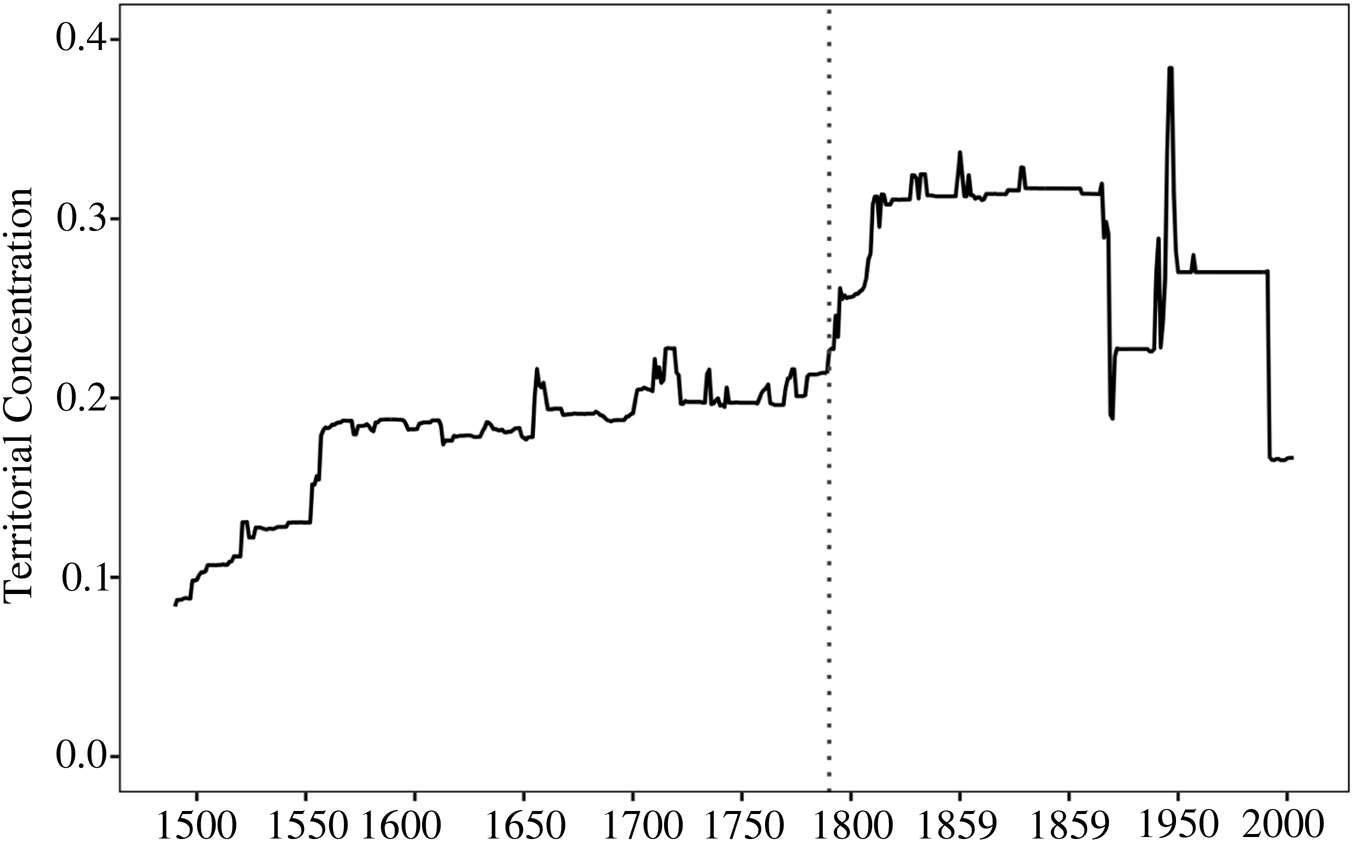
Figure 13. Territorial concentration, 1490–2003 (data from Centennia)
Clearly, the downward trend in territorial concentration from the early twentieth century presents bellicist theorizing with a puzzle. Several possible explanations can be offered for this shift, including emerging international norms against conquestFootnote 102 and a particularly powerful trend toward self-determination after World War II.Footnote 103 Related to these explanations, nationalism has had a mostly fragmenting influence on state size, leading to an overall net effect of disintegration rather than integration.Footnote 104
In contrast, Tilly focuses on nationalism as a major boost for the consolidation of the system and an accelerator of the formation of “national states.”Footnote 105 According to Tilly and others, the shift from indirect to direct rule occurred primarily after the French Revolution. Before then, virtually all states were composite: they consisted of subsequently added territories with a considerable amount of autonomy and without any uniform exercise of rule.Footnote 106 As of Napoleon's leveé en masse, nationalism revolutionized warfare, with profound implications for extraction and mobilization of resources based on the entire population.Footnote 107
Because Tilly does not, however, fully consider the border-transforming effects of nationalism, or changing international norms for that matter, his theory is able to account for the evolution of territorial concentration only until the early twentieth century. A full account of territorial state transformation until the early twenty-first century requires an extended, more general theory that traces the influence of international norms and nationalism's border-transforming effect. The task of developing such a theoretical framework falls well beyond the scope of the current study. Yet, until the early twentieth century, our index of territorial concentration indicates that the European state system was consolidating in agreement with bellicist expectations. A replication of the dyadic analysis using Centennia data for 1790 to 1915 shows that the link between warfare and territorial expansion remains very strong (see the online supplement).
Conclusion
Using a stylized model capturing the external logic of the bellicist account of European state formation, this paper offers an explicit evaluation of the paradigm. By combining data on state borders and warfare, we systematically disentangle war-related territorial gains from peaceful ones, while disaggregating the analysis to dyadic relationships. Our analysis thus improves on previous tests, which have been either qualitative, overly aggregated, or unable to address the nexus between war and state making directly.
What are we to make of all these findings? Do they vindicate Tilly's original claims about warfare and state formation in Europe? Part of the problem, it seems, is that the very meaning of “state formation” remains deeply ambiguous. Clearly, our evidence does not address the initial founding of the states in question, or the very invention of modern sovereignty as a concept. Nor does it seem reasonable to restrict territorial changes to Darwinian elimination of units through conquest. Several critics have relied on this strict version of bellicism to cast doubt on Tilly's theory in favor of pacific processes, including trade and coalitions, religion, or dynastic politics.Footnote 108 Despite contributing greatly to our understanding of state formation, these alternative accounts for the most part offer complementary, rather than competing, explanations.
Indeed, our findings confirm that war played a central role in the expansion and consolidation of European states’ territories. This is not to deny that the great European dynasties also helped shape state trajectories, but such a logic is at least partly compatible with war-driven expansion. For sure, in many cases, dynastic politics reflected the military balance. Many dynastic marriages were codified in peace treaties following wars.Footnote 109 Traditionally, dynastic entanglements put limits on territorial aggrandizement through conquest, especially through intermarriage turning female spouses in foreign royal families into “hostages.”Footnote 110 Yet a new generation of rulers started to emerge in the eighteenth century, including Charles XII of Sweden and Frederick the Great of Prussia, who put state interest before dynastic “family values.” This development, together with nationalism, broke the backbone of the ancien régime, paving the way for total warfare and ruthless war-driven expansion in the hands of Napoleon, Hitler, and Stalin, as analyzed and prophetically anticipated by Clausewitz.Footnote 111
All in all, there is ample evidence of a war-driven expansion process, within certain bounds, in early modern Europe, thus vindicating a nuanced interpretation of Tilly's original theory. In this very sense, war did make states, or at least made the surviving units larger. To be sure, the relationship between war and state expansion is explicitly endogenous, as Tilly's own dictum already suggests. To some extent, our cumulative gain and loss variables capture the observable implications of reciprocal causation in this positive-feedback process, but it is difficult to see how the entire macro process could be “exogenized” through instrumental variables or other approaches to causal identification. Obviously, this does not preclude more limited research questions being studied with such tools. In fact, recent sophisticated studies illustrate how to leverage instrumental variables, random shocks, natural experiments, and synthetic controls.Footnote 112 Still, our regression-based analyses with observational data provide solid support for the bellicist paradigm, which is further bolstered by our analyses of aggregate trends, state-level trajectories, and new data on peace agreements.
To reach this conclusion, we have had to abstract away from several important aspects of competitive state formation processes. For one, we have focused on violent conflict, without taking into account threats of violence (although see Table A4 in the online supplement). Threats are entirely in line with the war-fighting logic of bellicist theorizing. It is likely, however, that an analytical extension that incorporates bargaining processes would further vindicate a wider interpretation of the bellicist perspective because many cases of “peaceful” territorial change occurred when weak states succumbed to the threats issued by powerful states. In addition, as our coverage is limited to Europe, we cannot account for the vast territorial gains the European colonial powers made overseas, although these expansions, too, are in principle compatible with the war-centric logic.Footnote 113
Furthermore, throughout the analysis, we have focused on territorial size as the prime measure of power. Tilly's own theory offers a more sophisticated account that stresses how smaller states were able to survive for long periods thanks to access to capital.Footnote 114 By the time of the French Revolution, direct rule had not been successfully imposed on European populations, and in several cases never would be. A complete account of the European state formation process requires major theoretical amendments that go beyond Tilly's narrowly materialist reasoning.Footnote 115 In particular, the French Revolution and its aftermath ushered in a completely new type of political legitimacy that cannot be reduced to a mere amplification of state power.Footnote 116 Without full appreciation of the influence of nationalism, it is impossible to explain why direct rule could not be successfully implemented in the Habsburg and Russian empires, and how this failure eventually had fatal consequences for these polities.Footnote 117 Future research will need to study how territorial expansion interacts with the state's internal structuring, especially with respect to resource extraction and mobilization, thus bringing together systematic research covering both dimensions.
As suggested by the downward slope of territorial concentration from the early twentieth century in Figure 13, Tilly's theory cannot easily be extended to state formation in contemporary Europe. Nor is it advisable to extrapolate Tilly's Eurocentric theory to other parts of the world without theoretical modifications. Our model does not explicitly capture when negative feedback replaces its positive counterpart. Such an extension is needed to account for why some state systems collapsed into a single, dominant state. While the war-related positive-feedback mechanisms studied here may also apply beyond Europe in some cases, Huang and Kang show that in East Asia, emulation and learning rather than bellicist competition created the state system during the first millennium AD.Footnote 118 Likewise, Dincecco, Fenske, and Onorato find that, in Africa, warfare gave rise to “special-interest states” with high fiscal capacity and high levels of internal conflict.Footnote 119 Moreover, in today's world, peaceful interventions by international actors, rather than interstate war, dominate the external dimension of state building.Footnote 120 This could of course change, but Russia's struggle to make territorial gains in Ukraine following its invasion in February 2022 reminds us that international norms and nationalism make large-scale conquest very difficult.Footnote 121 These scope conditions do not entirely rule out limited territorial gains,Footnote 122 but today's international system clearly operates differently from early modern Europe.
Nevertheless, as Tilly himself emphasized, it is necessary to validate the theory in its original area of application before extending it beyond this historical starting point. As we have shown, the bellicist perspective remains key to understanding the process of European state formation in previous centuries.
Data Availability Statement
Replication files for this article may be found at <https://doi.org/10.7910/DVN/04QUNY>.
Supplementary Material
Supplementary material for this article is available at <https://doi.org/10.1017/S0020818322000352>.
Acknowledgments
Previous versions of this article were presented at the Workshop on International Borders in a Globalizing World at the University of Pennsylvania, 29–30 April 2021, at the University of Lund 25 November 2020, at Oslo University 30 October 2020, and in the Comparative Politics Colloquium at Princeton University, 11 March 2020. We are grateful for excellent advice from participants at those meetings and members of our research group, as well as Nils Weidmann. We also thank Maria Muñoz Murias, Tim Waldburger, and Benjamin Füglister for their invaluable research assistance.
Funding
This research has benefited from generous financial support from the Advanced ERC Grant 787478 NASTAC, Nationalist State Transformation and Conflict.


















